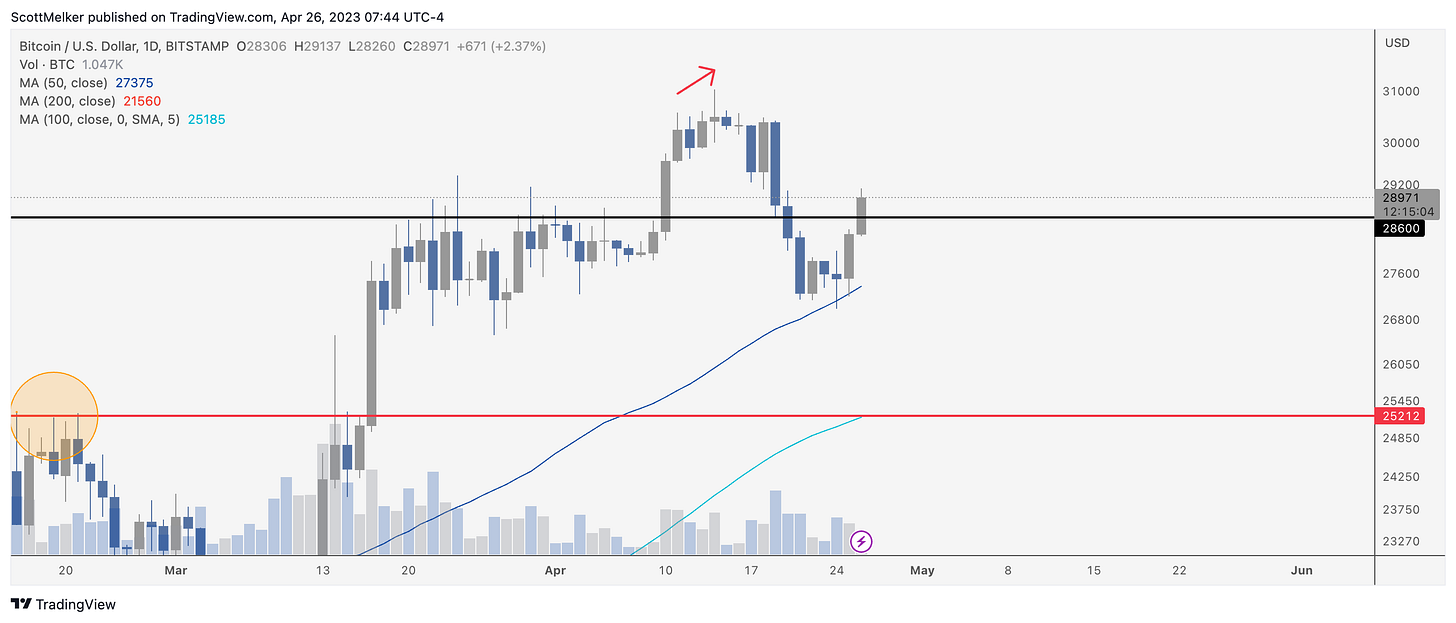Welcome to The Wolf Den! This is where I share the news, my ideas about the market, technical analysis, education and my random musings. The newsletter is released every weekday and is completely FREE. Subscribe!
Sign up for my other newsletter, THE DAILY CLOSE!
I built The Daily Close to give you the same institutional-grade indicators and signals that I use to trade the market on a daily basis. It's automatically generated and delivered to your inbox at the daily close everyday.
1 Week FREE for all subscribers
17% discount if you subscribe for a year
$25 a month, or $250 a year
In This Issue:
When Long-Term Investing Goes Awry
Bitcoin Thoughts And Analysis
Legacy Markets
ETH Staking Vs. High-Interest Yield
The Bitcoin Conference Is Soon
Meme Coins Mark The Top
Binance.US Bails On Voyager, Creditors Like Myself F*cked Again
FTX Lessons Learned | What Brett Harrison Is Building After The Collapse Of FTX
When Long-Term Investing Goes Awry
Seasoned investors recognize the value of long-term capital gains, but focusing solely on them can lead to hidden costs and potential issues. The advantages of long-term capital gains are clear – assets held for over a year are taxed at significantly lower rates than those held for shorter periods. However, as you strive to achieve long-term capital gains, your portfolio may become drastically imbalanced at times. This is an unavoidable aspect of long-term investing, and even a perfectly balanced portfolio can eventually transform into a disarrayed mess.
Picture a graph illustrating the performance of a hypothetical investment portfolio over time. The x-axis represents time, while the y-axis signifies the value of the portfolio. Each bar on the graph represents a single day, with different colors symbolizing a well-diversified and balanced portfolio on day one. As time progresses, some investments might perform better than others, causing drastic changes in the portfolio's composition and making it virtually unrecognizable.
An investor focused exclusively on achieving long-term capital gains may cling to both winning and losing investments for too long, leading to complex and undesirable situations. To simplify, let's consider a hypothetical scenario: stock A comprises 75% of the portfolio because it is deemed 'safe' and a 'slow grower,' while stock B accounts for the remaining 25% since it is considered 'riskier' and 'fast-moving.' Suppose that after six months, stock B's value increases by 500%, while stock A's value drops by 50%.
Our investor now faces a challenging decision when examining the bar graph that represents their portfolio's composition and gains. The imaginary portfolio has appreciated by 87.5% from the initial investment, which is positive, but critical risk-management choices still demand attention. Should the investor hold onto the winning investment (stock B) even as it becomes an increasingly larger portion of the portfolio? Should they be reluctant to sell stock A, hoping for a turnaround? If the investor only considers the capital gains tax implications, their final decision might lead to unintended consequences.
There is no definitive answer to what the investor should do, but several factors warrant consideration. What was the original plan for the portfolio? How have the outlooks for these two stocks changed over the past six months? Are randomness and variance the primary reasons for the stocks' performance? Can the investor maintain a reasonable conviction with the new composition? Should profits from stock B be reinvested into stock A? Should the investor let stock B ride while it's hot, set a stop loss, and consider that they were wrong about stock A? Are they capable of managing stock B's increased size and volatility?
This list merely represents the starting point of consideration for our hypothetical investor. And, importantly, capital gains tax hasn't even been mentioned yet. Successful investing entails mastering the art of evaluating all the ways in which the decision-making process can go awry and then proceeding along the path of least resistance. Long-term capital gains tax should be regarded as a final tool to leverage to your advantage, not a requirement or initial tool for your portfolio to perform well. Utilize this tool effectively, but do not rely on it to maximize success in any given time frame.
Bitcoin Thoughts And Analysis
Ok, playah.
Bitcoin dropped roughly 12-13% so far on this correction but sentiment felt like it was down 90% and in the depths of a bear market. Just as everyone started screaming for new lows, Bitcoin bounced off of the daily 50 MA, an obvious spot for a mean reversion trade.
Is this correction over? I have no idea. But a small drop after a nearly 2x run off the lows is no reason to flip flop bias.
Wow. I guess the exaggerated bullish divergence with oversold RSI was enough to send Bitcoin flying. RSI has already almost completed the round trip back to overbought in a single day.
What a move.
Altcoin Charts
Legacy Markets
US equity futures rose, boosted by strong earnings from tech giants Alphabet Inc. and Microsoft Corp., offering investors reassurance amid ongoing concerns about the economy. S&P 500 contracts climbed around 0.4% after the index experienced its largest monthly drop, partly driven by First Republic Bank's 49% plunge. Nasdaq 100 futures increased over 1%. Alphabet and Microsoft gained in premarket trading after beginning the Big Tech earnings season on a positive note. European stocks declined due to disappointing earnings, while US earnings revisions underperformed Europe. Worries over US regional banks eased slightly, and market participants are monitoring the Federal Reserve's aggressive tightening and its impact on the economy and lenders.
Key events this week:
Eurozone economic, consumer confidence, Thursday
US initial jobless claims, GDP, Thursday
Bank of Japan meets on interest rates, Friday
Euro-area GDP, Friday
US personal income, Friday
Earnings highlights:
Wednesday: Boeing, Meta, Hilton
Thursday: Amazon, American Airlines, Intel, Mastercard, Southwest Airlines, Hershey, Honeywell, Barclays
Some of the main moves in markets:
Stocks
S&P 500 futures rose 0.4% as of 6:10 a.m. New York time
Nasdaq 100 futures rose 1.3%
Futures on the Dow Jones Industrial Average were little changed
The Stoxx Europe 600 fell 0.7%
The MSCI World index was little changed
Currencies
The Bloomberg Dollar Spot Index fell 0.4%
The euro rose 0.7% to $1.1050
The British pound rose 0.6% to $1.2480
The Japanese yen rose 0.3% to 133.41 per dollar
Cryptocurrencies
Bitcoin rose 3.1% to $28,845.64
Ether rose 1.9% to $1,896.77
Bonds
The yield on 10-year Treasuries was little changed at 3.41%
Germany’s 10-year yield declined four basis points to 2.35%
Britain’s 10-year yield was little changed at 3.69%
Commodities
West Texas Intermediate crude rose 0.4% to $77.40 a barrel
Gold futures rose 0.2% to $2,009.10 an ounce
ETH Staking Vs. High-Interest Yield
Could it be that crypto staking is losing potential market share because major banks are offering competitive rates on savings accounts? It seems plausible. While staking retains its advantage, major banks are gradually approaching the attractive rates that were once considered exclusive to the crypto world. Moreover, if you're willing to deposit your money in a lesser-known bank, the rates can be even higher. Additionally, short-term treasury bills are yielding APYs just below 5%. As the U.S. clarifies guidance and regulations on staking and banks' unsustainable yields decrease (due to current economic policies), staking is likely to gain popularity.
Below is a comparison of the current Ethereum staking rates and high-interest account rates. Unfortunately, from the perspective of a conservative and traditional investor, one category seems like an obvious choice over the other.
Coinbase: 4.59% APY
Binance US: 5.7%
Lido Finance: 5.1% APY
Rocket Pool: 5.1%
Apple: 4.15%
Citi: 3.85%
Discover Online: 3.75%
American Express: 3.75%
The Bitcoin Conference Is Soon
The annual Miami Bitcoin Conference is fast approaching, scheduled for May 18-20, less than a month away! Last year's conference attracted approximately 30,000 attendees, while Bitcoin fluctuated around the mid $40k range. Ideally, Bitcoin will complete its correction before the conference rather than during, as has often been the case.
This year's speaker lineup features prominent names such as Mayor Dan Gelber, Bill Miller IV, Michael Saylor, Caitlin Long, Arthur Hayes, Jack Mallers, Lyn Alden, Adam Back, Jeff Booth, Robert Breedlove, Eric Wall, Jameson Lopp, and many more. Given that celebrities haven't been particularly effective at promoting Bitcoin, it wouldn't be surprising if there are fewer of them at this conference.
Meme Coins Mark The Top
In last week's intro, "I Smell Greed," I neglected to mention one of the indicators – the recent proliferation of meme coins. I have mentioned it repeatedly on twitter.
Profits typically cycle from coin to coin, with meme coins often representing the last stop or signaling the end (or cooldown) of a trend. We might have suspected that something was amiss when PEPE, with a circulating supply of 420.69 trillion tokens, experienced a staggering 21,000% gain in just a week. I tend to avoid meme coins because only a few investors come out on top, but it's important to remember that a surge in meme coins usually indicates a market peak.
Binance.US Bails On Voyager, Creditors Like Myself F*cked Again
What can I say? I went on a rant on YouTube last week about this deal, and the fact that I would not celebrate until I had money in my bank account.
I was right to be a skeptic.
Binance.US has withdrawn from its agreement to buy $1 billion in assets from bankrupt cryptocurrency brokerage Voyager Digital, citing "the hostile and uncertain regulatory climate in the United States." The deal had been approved on April 19 but was previously blocked by an emergency stay on March 28. Voyager and the Voyager Official Committee of Unsecured Creditors expressed disappointment at the development. Binance.US has decided to "terminate the asset purchase agreement," and it remains unclear what led to the change of heart. Voyager and the creditors' committee will now focus on distributing cash and crypto to customers directly via the Voyager platform.
The assumption here is that Binance.US has an uncertain future in the United States and cannot risk doing this deal.
Thank you, Gary Gensler.
FTX Lessons Learned | What Brett Harrison Is Building After The Collapse Of FTX
I sat down with Brett Harrison, the former Head of FTX US, to talk about his latest venture, Architect. In this episode of the Wolf Of All Streets, Brett shares insights and lessons learned from his time at FTX and how they influenced his new project. He delves into the inspiration behind Architect, a platform aimed at revolutionizing the world of financial infrastructure, and how it solves existing problems in the industry. The conversation also touches on the growing role of AI and its potential impact on the financial world. Tune in to discover the innovative ideas and perspectives of one of the most prominent figures in the cryptocurrency and fintech space.
In this episode with Brett, we discussed:
Architect
Access to CME
Who is Architect for?
Innovations in crypto exchanges
What’s left for Americans?
Regulatory clarity
Collapse of FTX
Compliance
What do we lack in DeFi?
Data provision
AI
Analytics x AI
The views and opinions expressed here are solely my own and should in no way be interpreted as financial advice. Every investment and trading move involves risk. You should conduct your own research when making a decision. I am not a financial advisor. Nothing contained in this e-mail constitutes or shall be construed as an offering of financial instruments or as investment advice or recommendations of an investment strategy or whether or not to "Buy," "Sell," or "Hold" an investment.















